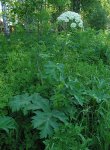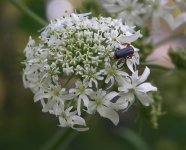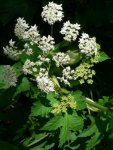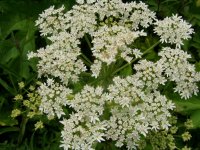Cowworm - heracleum l.
Family Celery (Apiaceae) - Umbelliferae
Botanical characteristics. Perennial herbaceous plant. It grows on mountain valleys, meadows, in thickets of bushes, tall grass.
Root core, fleshy, with large lateral sprouts. Stem up to 2 m high, from below naked or pubescent with sparse hairs, spiky, branching at the top. Leaves are large, petiolate, generally rounded-triangular, pinnate or triad. Leaflets ovate, shallow-vyamchatonadrasannye, with wide lobes, along the edge with unequal teeth. The flowers are white, collected in a complex umbrella. Fruit is a two-tiered. Blooms in June - July, fructifies in August.
There are several species, some of them belong to poisonous plants . In medicine, there are two types:
- Borshevik dissected - H. dissectum L. The stem reaches up to 2 m tall and taller. Leaves pinnately dissected. The stem and leaves are covered with hard hairs. The upper vagina is elongated, not expanded. Umbrellas are large, up to 50 cm across. Fruits are obovate, flat.
- Borshevik woolly - N. lanatum M. Stem up to 1.5 m in height, beneath bare, smooth, upper part ribbed, soft-pubescent. The upper vagina is swollen. Leaves are threefold. Umbrellas up to 30 cm across. Fruits are broadly ovoid.
Both species are similar in chemical composition, can be used similarly, replace each other or in combination.
Used parts of the plant. Medicinal raw materials are the aboveground part of the plant, stems, flowers, leaves, rarely fruits and roots harvested in the usual way.
Chemical composition. All parts of the plant contain essential oil and coumarins. Roots - polyacetylene compounds, steroids, phenols and their derivatives, phenol carboxylic acids. In the aerial part, flavonoids, vitamins are found; In flowers - aliphatic alcohols; In seeds - fatty oil.
Application. In folk medicine infusions and decoctions of leaves and flowers are used for dyspepsia, bronchial asthma, diarrhea, furunculosis, colic; Nanais - with gastrointestinal diseases, various skin diseases; In Tibetan medicine - with cholelithiasis, diseases of the kidneys and urinary tract.
The roots of the cow grouse in the form of a decoction are used for various female diseases, tumors, lymphadenitis, as haemostatic.
In the experiment, the preparations of the cow-grasshopper show antimitotic activity. Coumarins of fruits show antitumor effect.
Tincture of hogweed leaves is an effective tool for vitiligo .
Young leaves, roots and shoots of woolly and dissected cheesecook are edible, are a food product for the Indians of North America.
Preparation
- For infusion take 20 g of leaves and flowers, pour 200 ml of boiling water, insist on a water bath for 15 minutes, cool 45 minutes, filter. Take 2 tbsp. Spoon 3-4 times a day.
- For broth 15 g of roots pour 200 ml of boiling water, insist on a boiling water bath for 30 minutes, cool for 10 minutes, filter, make up to 200 ml. Take 2 tbsp. Spoons 2-3 times a day after meals.






Comments
When commenting on, remember that the content and tone of your message can hurt the feelings of real people, show respect and tolerance to your interlocutors even if you do not share their opinion, your behavior in the conditions of freedom of expression and anonymity provided by the Internet, changes Not only virtual, but also the real world. All comments are hidden from the index, spam is controlled.